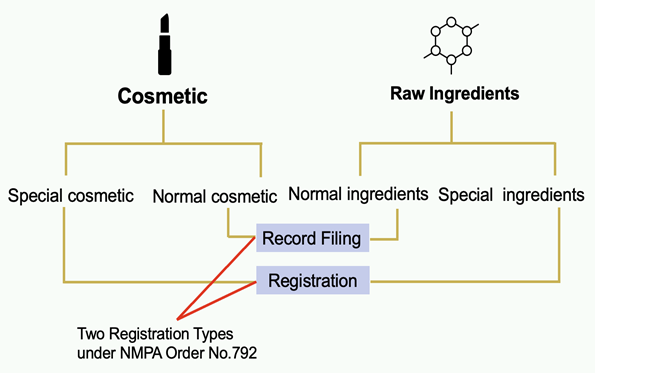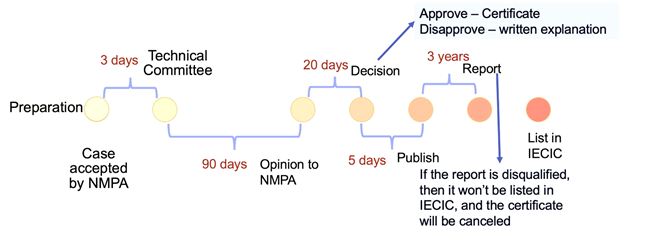China Reach Regulation for Various Sectors
China's State Council published the final version of the COsmetic Supervision and Administration Regulation (CSAR) and this came into force on 1 January 2021 and replaced the Cosmetic Hygiene Supervision REgulations. CSAR regulates all cosmetics and cosmetic raw materials in China. All the manufacturers, importers and exporters must ensure that their cosmetic products and raw ingredients meet the compliance obligations under CSAR before producing, importing, and exporting business.
Substances are divided into two categories:
- cosmetic raw ingredients
- cosmetic products.
Based on different types of substances, different submission procedures (record filing and registration) apply.

Cosmetic raw material is defined as natural or synthesis ingredients which are used in making cosmetic products. According to the requirements, existing ingredients need to do record filing submission, while new ingredients must do a formal registration to produce or place in China. The distinguished point for checking the procedure for ingredients Is to check if it falls within the cosmetic inventory.
IECIC stands for Inventory of Existing Cosmetic Ingredients in China. Currently, it contains 8972 existing cosmetic ingredients. In addition to the main inventory, there are seven cosmetic inventory lists that can be used in parallel with IECIC. If ingredients are found on the inventory, then it only needs to submit record filing.
|
Inventory lists |
Number listed |
Obligation under list |
|
List of banned ingredients in cosmetics (2021) |
1284 |
Not allow to use |
|
List of banned plant (animal) ingredients in cosmetics (2021) |
109 |
Not allow to use |
|
List of restricted substances in cosmetics (2021) |
47 |
Meet certain requirements |
|
List of preservatives allowed in cosmetics (2015) |
51 |
Allow to use |
|
List of sunscreen agents allowed in cosmetics |
27 |
Allow to use |
|
List of colorants allowed in cosmetics (2015) |
157 |
Allow to use |
|
List of hair dyes allowed in cosmetics (2015) |
75 |
Allow to use |
|
IECIC (2021) |
8972 |
Register / Record Filing |
New raw ingredients are defined as cosmetic ingredients that are not listed in the IECIC inventory.
Applicants need to submit the following documents to comply with CSAR:
- Applicant’s details which include name, address, and contact.
- Research and Development report which addresses the sources and properties of the ingredients, basis of efficacy, data, etc.
- Quality control standard. It needs to explain the process during the production of the cosmetic ingredient, quality specification index, testing methods, and possible risks.
- Safety evaluation report. Toxicological safety evaluation data, evaluation, and necessary toxicological test data must be given in this report.
The application may take up to 4 months before a decision is made. The technical committee will need around 3 months to undertake the evaluation work.

The registration timeline of cosmetic products is the same as cosmetic ingredients registration. But the submission documents are different. For cosmetic products registration, applicants need to prepare:
- The name, address, and contact information of the registration applicant filing person and manufacturer.
- product name, formula, or full product ingredients.
- Standards implemented by the product.
- Product label sample.
- Product inspection report.
- Product safety assessment data.
- Registrant qualification
For imported cosmetics, they must be labeled in Chinese and contain the following information:
- Product name, special cosmetics registration certificate number
- The name and address of the registrant, recorder, and entrusted production enterprise
- Cosmetic production license number
- The standard number of the product
- All ingredients
- Net weight
- Use period, method of use and necessary safety warnings
CSAR also introduces the annual reporting requirements. Applicants should submit the annual report of cosmetics from January 1 to March 31 each year.
- Basic information and production of new cosmetic ingredients.
- Information on cosmetic registrants, filers, or entrusted manufacturers who use new raw materials to produce cosmetics.
- Information on cosmetics using new raw materials, including product name, product registration or filing number, number of products produced or imported, sold, etc.
- Sampling inspection, investigation, and recall of cosmetics produced with new raw materials.
- The adverse reaction monitoring system, statistical analysis of adverse reactions, and measures of cosmetics produced with new cosmetic ingredients for cosmetics manufacturers.
- Risk monitoring and evaluation management system and measures of cosmetics produced with new cosmetic ingredients for cosmetics manufacturers.
On December 31, 2021, China’s National Medical Product Administration (NMPA) launched an online cosmetic ingredient submission platform. This platform, Cosmetic Ingredients Safety Information Registration Platform, will require companies handing existing cosmetic ingredients to submit information. The platform is created based the requirements of CASR (state council order No.727). For foreign cosmetic ingredient manufacturers, they can create their own accounts to submit information, or authorize representative companies to submit ingredient information on their behalf.
Cosmetics Raw Material manufacturers, domestic or overseas, are required to submit to the Cosmetic Ingredients Safety Information Registration Platform. Manufacturers can submit information by themselves, or they can appoint an authorized representative to submit and maintain ingredient safety information on their behalf. This applied to cosmetic raw materials regardless of its tonnage.
This applies to two types of substances:
-
Substance that are included in IECIC (Chemical Inventory, Inventory of Existing Chemical Substances Produced or Imported in China) but not listed in IECSC (Inventory of Existing Cosmetic Ingredients Produced or Imported in China)
-
Substances that are listed in IECIC and IECSC.
Basic information and manufacturing process
-
Trade name
-
Composition
-
Basic properties
-
Purpose of use
-
Suggested percentage in cosmetics
-
Restrictions on the use of raw materials
-
Properties
-
Physical and chemical properties
-
Brief statement of the Manufacturing process
Quality control requirements and characteristic indicators
-
Identification method
-
Quality and characteristics of ingredients
Limit requirements for risky substances
- Heavy metal
-
Microbiology indicators
-
Pesticide residue risk
-
Others
Assessment conclusions of international authorities
Brief description of the requirements for use in other industries
Other issues to be explained

 Twitter
Twitter
